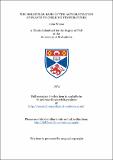Files in this item
The molecular basis of the acclimatization of plants to chilling temperatures
Item metadata
| dc.contributor.advisor | Crawford, R. M. M. | |
| dc.contributor.author | Wilson, John | |
| dc.coverage.spatial | 219 p. | en_US |
| dc.date.accessioned | 2018-06-20T15:35:02Z | |
| dc.date.available | 2018-06-20T15:35:02Z | |
| dc.date.issued | 1974 | |
| dc.identifier.uri | https://hdl.handle.net/10023/14360 | |
| dc.description.abstract | Leaves of tropical and sub-tropical species are rapidly chill-injured when exposed to temperatures in the 0 to 10°C range. In contrast, leaves of temperate and arctic alpine species can withstand these temperatures without damage. Chill-sensitive leaves can be divided into two categories based on their susceptibility to chilling-injury:- 1) Extremely chill-sensitive species which are rapidly damaged on exposure to temperatures between 12 to 15°C (e. g. Episcia reptans) and which cannot be readily hardened against chilling-injury. Maintaining 100 per cent relative humidity during chilling at 5°C does not prevent injury to these species, although the speed at which injury occurs is reduced. 2) Chill-sensitive species which are damaged in the 0 to 10°C range (e. g. Phaseolus vulgaris) and which can be readily hardened against chilling-injury at 5°C, 85 per cent RH, by 4 days growth at 12°C, 95 per cent RH, before chilling. Maintaining 100 per cent RH during t chilling at 5°C prevents injury to these species. It is considered that the primary response in chilling-injury is a temperature induced phase transition in the lipids of the cellular membranes from a liquid-crystalline to a solid gel state. The temperature at which the phase change occurs appears to be determined mainly by the degree of unsaturation of the fatty-acids associated with the phospholipids. The chill-sensitivity of leaves grown at 25&°C was related to a low percentage of linoleic and linolenic acid associated with each phospholipid. The degree of unsaturation of the glycolipids could not be related to, the chill-sensitivity of the species. Hardening the chill-sensitive species Phaseolus vulgaris and Gossypium hirsutum against chilling-injury at 5°C, 85 per cent RH, resulted in increases of up to 12 per cent in the percentage of linoleic acid associated with all the leaf phospholipids. The degree of unsaturation of the glycolipids did not change during hardening. The increases in unsaturation of the phospholipids were shown to be positively related to the increased tolerance of the plants to chilling by the fact that similar increases did not occur during the growth of chill-resistant Hordeum vulgare at 12°C and the ineffective attempts at hardening chill-sensitive Episcia reptans over 4 days at 15°C, the lowest temperature this species can withstand without injury. Chilling-injury in Phaseolus vulgaris could be prevented by enclosing the plants in polythene bags at 5°C, thus maintaining 100 per cent RH. However, leaves of this species transferred from 25°C to 5°C. 100 per cent RH and 12°C, 100 per cent RH for 4 days did not harden against subsequent chilling-injury at 5°C 85 per cent RH. In agreement with this finding no increase in unsaturation of the phospholipids was detected over 4 days growth at 5°C 100 per cent RH, and 12°C 100 per cent RH. It is suggested that plants grown at 5 and 12°C 100 per cent RH, by enclosure in polythene bags do not harden against subsequent chilling- injury at 5°C 85 per cent RH, because the carbon dioxide concentration within the bag is rapidly lowered by photosynthetic fixation. This results in the cessation of photosynthesis and a reduced supply of the cofactors oxygen and NADPH available for desaturase activity, thereby preventing an increase in the degree of unsaturation of the phospholipids. An increase in leaf age at 25°C was shown to increase the susceptibility of chill-sensitive plants to chilling-injury. This increase in susceptibility of older leaves to damage was related to a decrease in the degree of unsaturation and weight of phospholipids with increase in physiological age at 25°C. In conclusion, the results reported in this investigation provide evidence that hardening chill-sensitive leaves prevents chilling-injury by increasing the degree of unsaturation of the membrane phospholipids thereby lowering the transition temperature of the lipid layer of the cellular membranes. This phase change does not occur on chilling chill-resistant plants but may occur at sub-zero temperatures and increase their susceptibility to freezing-injury. | en_US |
| dc.language.iso | en | en_US |
| dc.publisher | University of St Andrews | |
| dc.subject.lcc | QK756.W5 | en |
| dc.subject.lcsh | Plants—Effect of cold on | en |
| dc.title | The molecular basis of the acclimatization of plants to chilling temperatures | en_US |
| dc.type | Thesis | en_US |
| dc.contributor.sponsor | Natural Environment Research Council (NERC) | en_US |
| dc.contributor.sponsor | University of St Andrews. Research Scholarship | en_US |
| dc.type.qualificationlevel | Doctoral | en_US |
| dc.type.qualificationname | PhD Doctor of Philosophy | en_US |
| dc.publisher.institution | The University of St Andrews | en_US |
This item appears in the following Collection(s)
Items in the St Andrews Research Repository are protected by copyright, with all rights reserved, unless otherwise indicated.

